Calathea (Rattlesnake Plant, Zebra Plant): Types, Care and More Growing Tips

Calathea is a genus of tropical houseplants native to South America and Asia. Many types of calatheas thrive as indoor plants. Calathea houseplants are known for their large colorful leaves with intricate patterns. The names of calathea species such as the Zebra plant (Calathea zebrina), Rattlesnake plant, Pinstripe plant, and Medallion plant, come from the beautiful designs on their leaves.
How to Care for a Calathea
Calathea plants thrive indoors in bright, indirect sunlight when planted in moist, well-draining soil. Mist your calathea regularly to increase humidity and water when the soil is partly dry. Average room temperatures are perfect for a calathea to grow well. The hardy houseplant needs fertilizer every four weeks during summer.
Caltheas and Prayer Plants
Sometimes calatheas are called prayer plants because they raise their leaves at night like prayer plants. In the evening, the leaves of calathea plants fold upright at the base of the stem, as if the plant is folding its leaves upward to pray. This process is called nyctinasty. Both calathea and prayer plants have variegated leaves.
The leaves of calatheas sometimes curl up from the outer edges inward toward the central vein because something is wrong in their environment. To prevent leaf curl make sure to keep your calathea plant in warm, humid and away from direct sunlight. Make sure your houseplant has partly moist soil.
Please read this article to find out the difference between calatheas and true prayer plants, marantas.
About Calatheas
There are many species of calatheas and hundreds of cultivars and they all belong to a family of flowering plants known as Marantaceae. However, calatheas rarely flower indoors. Some types of these ‘praying plants’ have large oval leaves with dark purple and pink patterns. Other calatheas have lance-shaped leaves with striped patterns in varying shades of green. Similar to true prayer plants (marantas), some calathea varieties have leaves with undersides that are a different color from the top side.
In this article, you will learn about some of the most popular and stunning types of calatheas. In the calathea care guide, you will find out the best way to care for these tropical houseplants.
Calathea Plant Types
Let’s look at some of the best examples of calatheas that can add some nature to any room, office, or indoor space.
Calathea roseopicta ‘Corona’
This popular calathea cultivar has large ovate light green leaves. The distinguishing features of the ‘Corona’ are the wide dark-green margins on the leaf edge and burgundy-purple colored underside.
Calathea ‘Eclipse’

The stunning calathea ‘Eclipse’ has thick large oval dark green leaves with pink and silvery patterns.
Rattlesnake Plant (Calathea lancifolia)
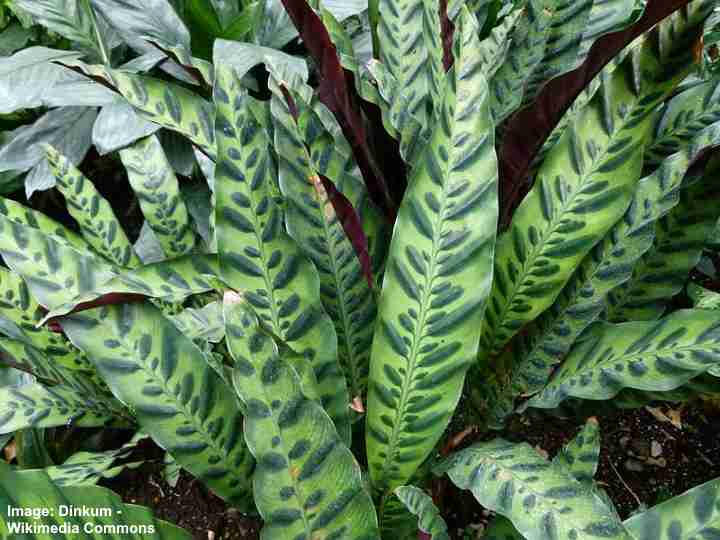
This bushy tropical houseplant gets its scientific name from its lance-shaped foliage. The leaves are light green with distinctive dark green patterns on the leaves. These designs seem to resemble a stem with smaller ovate-shaped leaves. The underside of the leaves is a deep burgundy red color.
Zebra Plant (Calathea zebrina)

This easy-to-care-for evergreen houseplant has light-green ovate leaves with dark green zebra-like patterns and stripes. The Zebra plant makes for a beautiful table accent where you can enjoy the purple underside of the leaves.
Pinstripe Plant (Calathea Ornata)

The calathea ornata (Pinstripe plant) is another perennial tropical plant that is easy to grow indoors. The Pinstripe calathea has large attractive dark-green leaves with pin-stripe markings. The veined markings are usually light green but some pinstripe plants have pink stripes.
Learn How to Care for Calathea Ornata (Pinstripe Calathea)
Calathea Warscewiczii
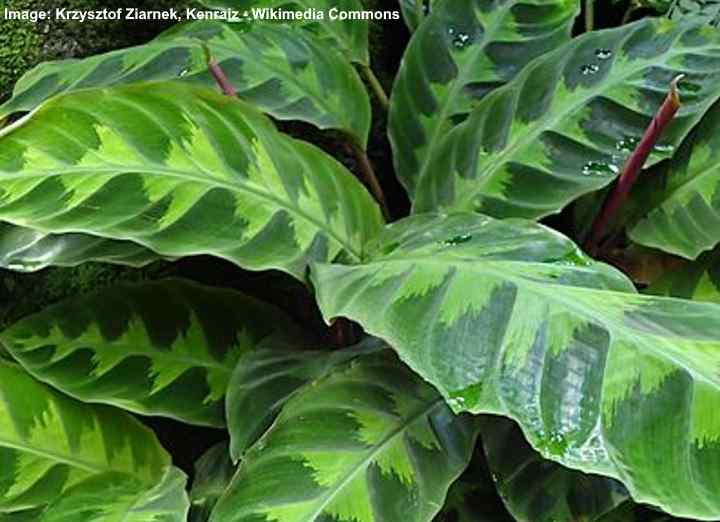
This tropical evergreen calathea has large dark green lanceolate-shaped leaves. The green leaves have light green fishtail patterning and maroon-purple coloring on the underside.
Calathea Medallion
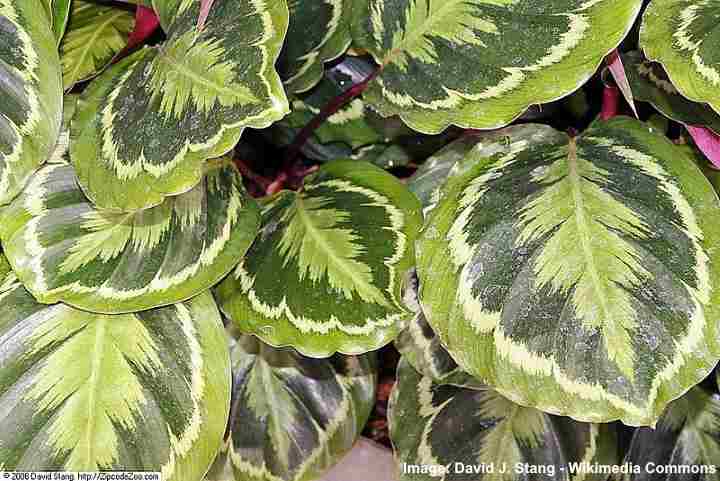
The calathea Medallion is one of the most popular calatheas because of its large dark-colored leaves. The top side of the leaves is dark green with emerald green and silver patterns. As with most calatheas, the Medallion leaves are a dark burgundy or purple color on the underside.
Rose-Painted Calathea (Calathea roseopicta)

The Rose-Painted calathea gets its name from the rose-colored pink stripes that seem to be painted along the veins. The large rounded leaves have dark green and light green patterns. The leaves also have dark green feathered margins with creamy-colored markings.
Calathea Veitchiana
Intricate, delicate patterns and glossy green leaves help to distinguish this calathea from other species. Dark green, light green and cream-colored patterns make this houseplant a showstopper. This calathea type has dark green leaves with feathery markings in shades of green, and red/purple undersides.
Calathea Beauty Star
This name of this calathea accurately describes its attractive light green foliage. The elongated oval leaves taper to a point and have beautiful lime-green feathering and fascinating pink stripes.
Calathea makoyana (Peacock Plant)
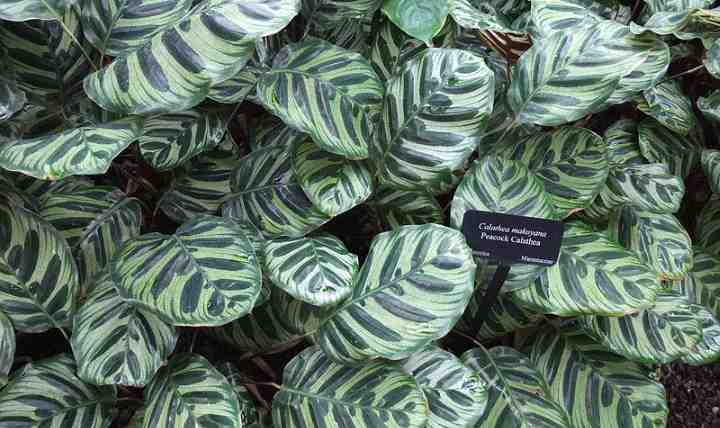
The calathea peacock plant has large light glossy green leaves with dark green veins and blotchy patterns. This calathea type has attractive foliage that has a pattern reminiscent of a peacock’s tail feathers. New leaves grow rolled up exposing the purple color underside.
Calathea ‘Misto’
The popular calathea ‘Misto’ has two-toned green-colored leaves. The shiny foliage is dark green with light green feathering in the middle of the leaf.
Round-Leaf Calathea (Calathea orbifolia)

The attractive calathea orbifolia has large oval leaves with silvery gray and green patterns. The stripy pattern on the leaves makes this round-leaf calathea an attractive plant for your room.
Calathea Musaica (Network)
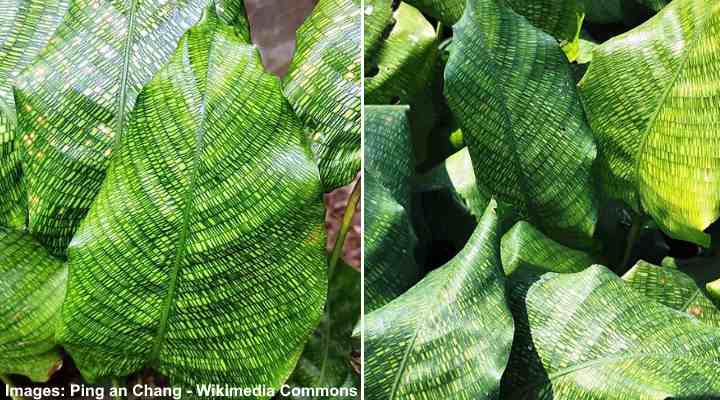
One of the most unusual species of calathea is the calathea musaica (Network plant). The lush green leaves of this calathea variety have an intricate network pattern in a light yellow to cream color. Unlike most types of calathea, the underside of the leaves is the same color as the top side.
Calathea Care
Calatheas are easy plants to grow at home if you care for them properly. The most crucial tips when caring for calatheas are to have plenty of humidity and keep the soil partly moist. If you get these conditions right, you will have an attractive tropical plant to enrich any room of your home.
During the summer, you can grow your calathea outdoors in temperatures of between 65°F and 75°F (10°C-24°C). The ideal growing zones for calatheas outdoors are 10 and 11.
Let’s look in more detail at what you need to do to properly care for a calathea.
Calathea Light Requirements
Calathea plants grow well indoors in bright rooms that get plenty of indirect sunlight. The best place for a calathea is on a west-, east-, or north-facing windowsill. Calatheas are house plants that can grow in low-light conditions. However, you may lose some coloring of the leaves.
For your calathea to thrive, aim for 6 to 8 hours of bright light daily. If you notice that the green foliage starts looking washed out, it could be because your plant is getting too much direct sunlight or not enough light.
Growing your calathea in bright light will help keep the variegated leaves of pinstripe calatheas, rose-painted calatheas, and calathea vetichiana plants colorful and vibrant.
If you have a calathea growing near a south-facing window, make sure to shade it from direct sunlight.
How to Water a Calathea
You should water your calathea when the top 1” (2.5 cm) of the soil has dried out. Use room temperature water and water until it drains out of the bottom. Calatheas need partly moist soil to thrive and don’t grow well in soggy soil or bone-dry soil.
The trickiest part of looking after a calathea is getting the moisture levels right. Too much watering can cause your calathea to droop and look as if it’s dying. If you don’t water it enough, you may see brown marks on the leaf edges or tips.
To know how often to water a calathea, always check the soil to make sure it’s partially dry. In the summer, you may have to water your tropical houseplant weekly and then less frequently in winter.
Humidity Requirements for Calatheas
Calatheas are tropical plants that need plenty of humidity to thrive. The easiest way to care for your plant is to mist the calathea daily. You can also get adequate moisture by using a humidifier or placing your plant pot on a pebble tray with water in it.
Because average room humidity is less than the tropics, you need to make sure air moisture levels are humid enough. Levels of more than 50 percent humidity are perfect for calatheas. Avoid over-watering your calathea to increase humidity. Misting the leaves will provide plenty of moisture without making your soil too damp.
Brown edges on your leaves can be a sign that you need to up the humidity levels.
Heating during winter tends to dry the air in your house. So, you may need to mist your more frequently during winter and water it less than in summer.
Calatheas with larger round leaves such as the C. roseopicta ‘Medallion,’ calathea ‘Eclipse,’ or C. makoyana may need more frequent misting than smaller leaf species.
The Best Temperature for Calatheas
Zebra plants, Peacock plants, Rattlesnake plants and other types of calatheas thrive in temperatures between 65°F and 85°F (18°C – 29°C). Keep your leafy tropical houseplants away from cold drafts or hot radiators. If the temperature drops below 60°F (15°C), you may notice the leaves start to curl.
Average room temperatures and high humidity help to create a similar environment to where calatheas grow. Try to avoid sudden changes in temperature so as not to stress your plants. In hot summers, when you have the air conditioning on, make sure your calathea is well away from the cold air.
Soil for Growing Calatheas
The ideal soil to care for healthy calathea growth is a well-draining potting mix. A potting mix with a blend of soil, peat moss, and perlite retains moisture but doesn’t become soggy. You can also buy African violet potting soil to grow a healthy calathea.
Getting the soil right is the perfect way to grow a calathea with healthy roots and leaves. To make sure that soil drains well and is aerated, put a layer of clay pebbles on the bottom of the pot. It is also essential to prevent your plant from becoming rootbound as this holds in moisture.
One excellent calathea care tip is to avoid putting mulch or stones on the top of the soil. Although this helps lock in moisture, there is less humidity through evaporation.
Fertilizer to Care for Calatheas
Calatheas don’t have a lot of care needs when it comes to fertilization. If you decide to fertilize your plant, then diluted liquid kelp or houseplant fertilizer is ideal. Only fertilize a calathea once a month during spring, summer, and fall.
As a general rule, when feeding calatheas remember that less is more. Signs of over-fertilizing include yellow leaves and weak growth. At the end of the article, you will find out how to care for problems with growing a calathea.
Calathea Propagation
Propagating a healthy calathea is not easy. Unlike other plants in the arrowroot family, calathea propagation is usually by plant division. Remove the existing plant from the pot and shake off excess soil from the roots. Gently divide the root segments leaving a few stems and leaves on each one.
To grow a new calathea, put the plant in a suitable pot that has a moist, well-draining potting mix. Make sure the calathea is planted at the same depth as it was before. After repotting, cover with plastic to prevent moisture loss and place in a low-light area. When your healthy propagated calathea starts growing, put in a bright spot.
Successfully propagating calatheas means you can gift beautiful calathea ornatas (pinstripes), ‘Misto’ plants, or ‘Peacock’ calatheas as attractive houseplants.
Repotting a Calathea
It is usually necessary to repot a calathea every year to prevent it from outgrowing its pot. Choose a container that is 1” to 2” (2.5 – 5 cm) wider than the current one. Remove the plant from its existing pot, check for root damage, and put in its new pot.
To prepare your new container, put a layer of pebbles at the base and half fill with calathea potting mix. Ideally, you should plant the calathea at the same depth it was in the previous pot. Water thoroughly and place on a shelf, tabletop, or windowsill to liven up your room.
Pruning Your Calathea
To keep your calathea plant looking healthy and vibrant, prune off any dead or yellow leaves. Older leaves usually need trimming to care for an attractive calathea. If you notice brown tips appearing, you should trim the leaves off. New, healthy leaves will grow in their place.
If you frequently get brown or yellow leaves, there may be an underlying cause. So, pay attention to watering, feeding, or light. Any one of these factors or a combination of them can cause growth problems.
Don’t worry about brown tips on the leaves. These are relatively common and you can use a pair of sterile pruning shears to trim off the brown edges.
Are Calatheas Toxic?
There is no evidence to suggest that calatheas are poisonous to cats, dogs, or other household pets. You can also handle the plants safely without risk of skin irritation.
Calathea Flowers
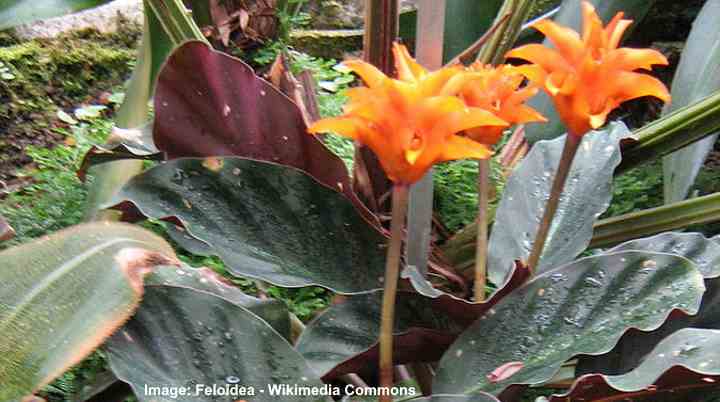
Calathea ‘Crocata’ has beautiful orange flowers
Although calatheas are a type of flowering tropical plant, they rarely flower indoors. Most people keep calatheas for their beautiful patterned foliage rather than their flowers.
Some species of calatheas flower indoors. For example, the calathea ‘Crocata’ produces beautiful orange flowers. This houseplant species is also called the flowering calathea.
Even though your calathea may never flower, they still brighten up a room with their colorful foliage. Especially the calathea Picturata, Pinstripe calathea, and Zebra plants all have bright green leaves with creamy-white veins or markings. Also, don’t forget the calathea cultivars such as ‘Corona,’ ‘Dottie,’ ‘Eclipse,’ and ‘Rattlesnake’ plants for their deep purple and burgundy foliage.
Calathea Care: Pests
Like most houseplants, pests and diseases can affect all calatheas. Spider mites are the most common type of pest to afflict these leafy indoor plants. Occasionally, aphids, mealybugs, and scale insects can cause problems.
Neem oil is one of the best ways to eradicate plant-destroying pests. Read this article to find out how to get rid of houseplant pests naturally.
Calathea Care: Diseases
Over-watering your calathea is the most common reason for fungal and bacterial diseases. These diseases usually show up as black or dark leaf spots. The causes could be related to pseudomonas bacteria or fusarium fungal diseases.
To treat these plant diseases, it’s essential to repot your calatheas in a fresh potting medium. You will have to thoroughly sterilize your pots to prevent fungal or bacterial diseases from spreading.
Waterlogged soil can also lead to root rot, which causes yellowing and wilting leaves.
The best way to prevent diseases and pests affecting your calatheas is to care for them properly. Water only when the soil is partly dry, mist regularly, and apply calathea fertilizer once a month to grow healthy calathea houseplants.
Related articles:
